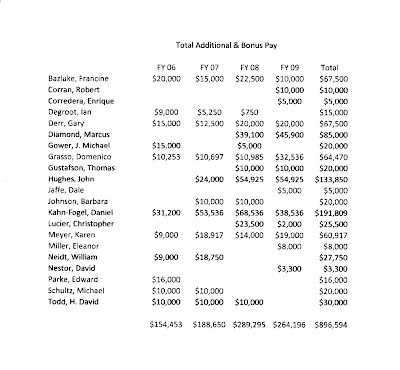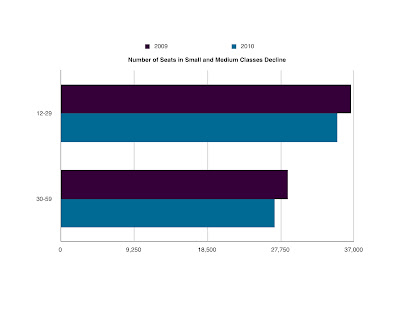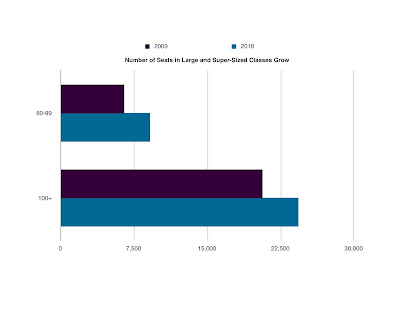....President Fogel is on the defensive and the press coverage no longer assumes that layoffs are inevitable, necessary, or can be done without harm to education on the ground. Read on for a sampling of coverage from yesterday's press conference and the sharp rebuke of Fogel and his spending priorities/downsizing plans delivered this morning to trustees by Faculty Senate President Robyn Warhol-Downs.
On Vermont Public Radio:

UVM faculty ask Board to slow down on budget cuts
Friday February 6, 2009
(Host) University of Vermont students and faculty say the Board of Trustees should consider alternatives to layoffs and budget cuts. The Board is meeting this week to get an update on the school's response to an estimated $28 million shortfall.
Education Professor David Shiman is the president of United Academics, the union that represents faculty. Shiman says administrators should instead be looking at the endowment.
(Shiman) "So why not look at this in the way other universities have, and say are there ways that we can tap into this, to give us some breathing room to make decisions. I think another way is to look down the hallway, and look at the salaries and say are there some issues that the administration can look at, as far as compensation for upper level administrators.''
(Host) Shiman says that administrators should not act so quickly on cuts. Deans have submitted plans for layoffs and budget reductions. Nursing Professor Judith Cohen says the threat of layoffs have been stressful for faculty. And she says necessary programs like hers shouldn't face cuts:
(Cohen) ``It makes absolutely no strategic sense given the University's emphasis on health and increasing enrollments that resources are not forthcoming to support programs at UVM where there is a high interest and even greater societal need."
(Host) UVM president Dan Fogel says the school may be able to avoid layoffs by eliminating vacant positions. And Fogel says no decisions will be made until the size of potential state appropriations are known.
In the Burlington Free Press:
UVM faculty, students decry cutbacks
By Tim Johnson
Free Press Staff Writer
One day before the University of Vermont's trustees convened to review UVM's fiscal woes, faculty and students gathered Thursday to decry anticipated budget and program cuts, and to urge restraint.
They contended that larger classes and stretched resources would detract from staff morale, from the quality of education and from the appeal that UVM holds for prospective students as a small research university -- arguments that the administration sought to counter with a response late Thursday afternoon. And the protesters urged alternative ways to meet the budget shortfall: by spreading some of the structural reductions over three or four years, by reducing expenditures for top-level administrators and by drawing on a small percentage of the endowment.
How seriously trustees will take these and other ideas is an open question. The board is expected to receive an update today from the UVM administration on the process of formulating a budget for the next fiscal year, to begin July 1. UVM administrators have said they have to make up for a $28 million shortfall in that spending plan and have obtained budget-cutting recommendations from each of the university's deans.
The administration has said details on the new budget would be released this month. Reductions in teaching staff (fewer lecturers, open positions left vacant), layoffs and bigger classes are anticipated.
David Shiman, president of United Academics, the faculty union, said a recent survey revealed anger, frustration and sadness as common faculty reactions to uncertainties surrounding the budget and university structure. He took issue with what he said was the administration's penchant for basing policy decisions on student-faculty ratios that the faculty never agreed to and that don't reflect the educational values to which UVM aspires.
Any spending cuts should be "patient, thoughtful, strategic," Shiman said.
"Don't start with the faculty and staff," he said. "That's the last place you go, not the first." He said he expected the trustees to put cogent questions to administrators charged with drawing up the budget.
Shiman's remarks kicked off an hourlong news conference in the Waterman Building.
Stephanie Kaza, a director of UVM's environmental studies program, said popularity of the program is surging (majors and minors increased by more than 22 percent, to more than 600 students) but that with just 6.2 fulltime-equivalent positions, faculty are hard-pressed to meet all the needs. Instead of increasing faculty resources, she said, she is only hearing about cuts.
Three students said they feared that the educational attributes that drew them to UVM are in jeopardy.
"A big school with a small-school feel -- that's what really attracted me to UVM," said first-year student Peter Helm, adding that student-professor relationships were "the best part of this school." Yet the expected budget cuts, he said, "would radically change my experience at UVM."
Judy Cohen, professor of nursing, said cutbacks to the nursing faculty and nursing undergraduates would fly in the face of the state's growing health needs and of an economy that counts health professions as one of the few growing sectors.
Responding for the administration, UVM spokesman Enrique Corredera said in an e-mail: "The quality of UVM's educational experience has been on the rise. The changes we are pursuing will only enhance our quality and allow us to use our resources more wisely.
"Some classes are too small and don't meet new minimum requirements," Corredera said. "We expect that small classes with fewer than 11 students will be affected the most. ... The vast majority of UVM classes will have the right number of students. We will continue to rank very high among peers in the number of small classes we offer."
He added that "the budget challenges we face affect all levels of our operation. Budget reductions are indeed affecting senior members of the administration."
The protesters passed out data showing percentage growths in salary spending for deans and executives that exceeded those for faculty in 2002-08, along with a letter to trustees that United Academics sent last week.
The letter said in part: "Some prominent faculty who have long been strong supporters of UVM are now questioning whether they can, in good conscience, stand in front of prospective students and tell them that this university still offers a high-quality education."
Professor Robyn Warhol-Down's Address to Trustees:
I. The three minutes that the President of the Faculty Senate is allotted on the agenda do not begin to be enough time to convey the anxiety, dismay, anguish, and outrage that many faculty are expressing right now. I have timed this report at four and a half minutes. I trust you will grant me that extra ninety seconds, and listen to what the faculty have to say.
II. First, the faculty are dismayed by the priorities and the approach to budget cutting that the central administration and the deans have taken. The faculty wants to keep all our valued colleagues on the staff and faculty at UVM, and not to see them fired, laid off, or “non-reappointed.” Behind every so-called “routine non-reappointment” is a part-time faculty colleague’s professional life and livelihood, a teacher’s relationship to a community of students. Everything and anything else that does not directly produce revenue needs to be eliminated before one faculty or staff colleague loses a job. For one example, catering bills. Like that [indicating the buffet table]—when faculty gather for department meetings or college meetings, there is no Sodexho coffee, no Pellegrino, no scones. We bring our own coffee. The university does not pay for that. For another
example, tonight there will be a lovely dinner for 100 people, celebrating retiring trustees, which is appropriate and as it should be. But were any of us who are attending asked to write a check for our dinners? If the faculty has a retirement party for a colleague we pay for our own meals. The university does not pay for that. Or executive bonuses—faculty do give our support staffs bonuses around the holidays, but the money represents gifts from our own pockets. The university does not pay for that. Or our increasingly lavish and admittedly beautiful Commencement celebrations—this university cannot afford to pay for that. These amounts might sound to you like nickels and dimes, but if you knew what a part-time faculty member earns, that would sound like nickels and dimes to you, too.
III. Second, the faculty are resisting the prospect of large-scale institutional restructuring, not because they are afraid of change, but because they are fearful about the rapidity of the process for initiating it. The faculty need to hear direct assurance
(as I heard from Chairman Boyce in his report this morning) that no degree program can be canceled, moved into or out of a college, or recombined with another program without first going through the review, debate, and approval process mandated by the Faculty Senate. By now you, the Trustees and you, the central administration cannot say this soon enough or often enough to allay all the anxiety out there.
IV. And finally, the faculty are still reeling from the invitation of Ben Stein to speak at Commencement and receive an honorary degree, although of course everyone is relieved that he will not be coming. The press and the public have misunderstood the grounds for the faculty’s rejection of Ben Stein. This is not political correctness, nor is it about silencing people who hold controversial (or conservative) views. When Ben Stein spoke at UVM last year, it didn’t cause a ripple. The problem this time was that this person who profits enormously by his professed rejection of science was to be honored with a UVM degree. The faculty confers degrees, and for such a person to receive one from this faculty was an impossibility. Learning that he was to be paid $7,000--more than most part-time faculty members earn for teaching a whole semester’s course--added insult to
injury.
V. In 26 years at UVM I have seen the faculty this riled up only two times, once just before the end of George Davis’s presidency and once just before the end of Tom Salmon’s. I speak for the Executive Council of the Senate when I say we strongly support Dan Fogel’s presidency and we would not want to see it end for many years to come. But this kind of upset among the faculty leads to real institutional instability, and it cannot be ignored.







